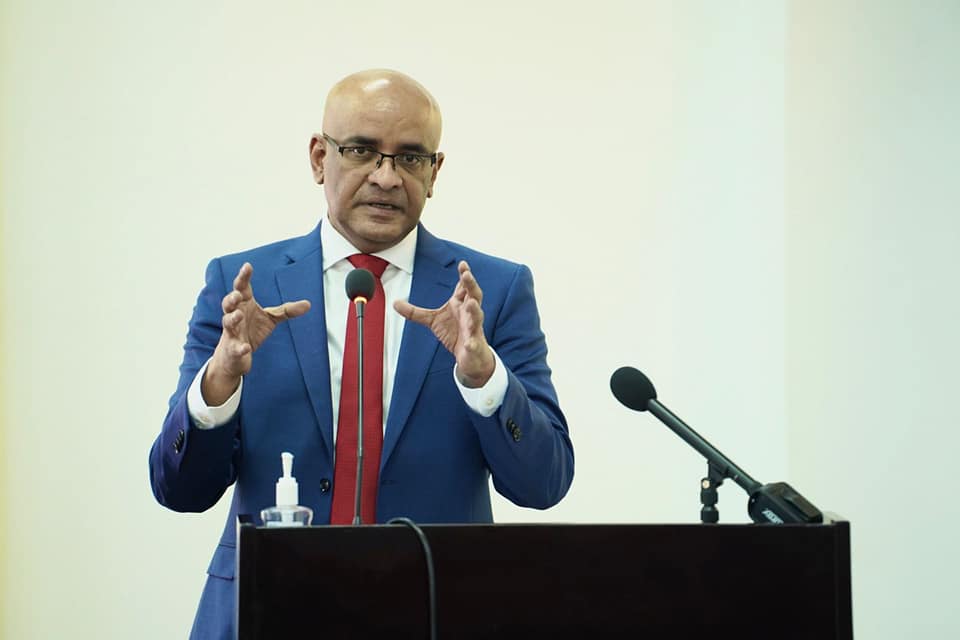Exxon granted approval from Guyana to conduct carbon-capture study – VP Jagdeo
 The Liza Unity FPSO, Guyana’s second oil production vessel.
The Liza Unity FPSO, Guyana’s second oil production vessel.
Guyana’s Vice President Dr Bharrat Jagdeo has announced that ExxonMobil has been given the proverbial green light by the government to conduct studies on carbon capture and storage (CCS) so that the company may utilize it in its local operations.
This approval was granted to ExxonMobil affiliate Esso Exploration and Production Guyana Limited following a request by the company, Dr Jagdeo indicated during his keynote address to the Georgetown Chamber of Commerce and Industry’s (GCCI) 132nd annual awards ceremony held in Georgetown on Thursday.
“Exxon sought permission and we have given that permission to do a study on carbon capture and storage,” Mr. Jagdeo said.
Speaking at the same event, President of ExxonMobil Guyana, Alistair Routledge also alluded to the company’s carbon capture initiatives.
“On a corporate level, ExxonMobil announced our Low Carbon Solutions business to commercialize our extensive low-carbon technology portfolio, which is initially focused on Carbon Capture and Storage, advancing plans for multiple new opportunities around the world to enable large-scale greenhouse gas emission reductions,” he said.
Carbon Capture and Storage (CCS) is the process of capturing carbon dioxide (CO2) that would otherwise be released into the atmosphere from industrial activity, and injecting it into deep geologic formations for safe, secure and permanent storage. The United Nations Intergovernmental Panel on Climate Change (UN-IPCC) and the International Energy Agency (IEA) have agreed that CCS is one of the most important low-carbon technologies required to achieve societal climate goals at the lowest cost. CCS is also one of the only technologies that could enable some industry sectors to decarbonize, including the refining, chemicals, cement and steel sectors.
ExxonMobil is a leader in carbon capture, with over 30 years of experience in CCS technology and current carbon capture capacity totalling about nine million tons per year. Cumulatively, the oil major has captured more CO2 than any other company – 120 million metric tons – accounting for approximately 40 per cent of all the anthropogenic (man-made) CO2 that has ever been captured. This figure is equivalent to the emissions of more than 25 million cars in one year.
Further to this, ExxonMobil’s Low Carbon Solutions is advancing plans for more than 20 new carbon capture and storage opportunities around the world to enable large-scale emission reductions. Earlier this year, the oil company announced its plans to invest $3 billion on lower-emission energy solutions through 2025.
Currently, this oil major is collaborating with multiple partners across industry, academia and government to advance carbon capture technologies to reduce costs and enhance scalability. This includes the company’s work with FuelCell Energy to advance carbonate fuel cell technology to more efficiently capture CO2 from industrial facilities, and Global Thermostat, a collaboration to advance efforts to capture CO2 directly from the air.
Notably, Co-Director of Energy Practice at America’s Market Intelligence (AMI), Arthur Deakin believes that the best path for new oil producer Guyana is through the utilization of ExxonMobil’s CCS technology and the implementation of a carbon tax. OilNOW had reported Deakin as saying that CCS technology is the “cheapest and most advanced option” for reducing emissions in heavy industries.
Along with Exxon’s expertise in CCS technology, Deakin had recommended that the Guyanese government implement an attractive carbon pricing framework to provide market certainty. The government is in favour of a stronger carbon price and to show this, it increased the fee for flaring offshore Guyana from US$30 to US$45 per tonne of carbon emitted. The Ali-led administration has also highlighted the importance of a strong carbon price in its updated Low Carbon Development Strategy (LCDS) 2030.

 Dr. Bharrat Jagdeo, Vice President of Guyana.
Dr. Bharrat Jagdeo, Vice President of Guyana.